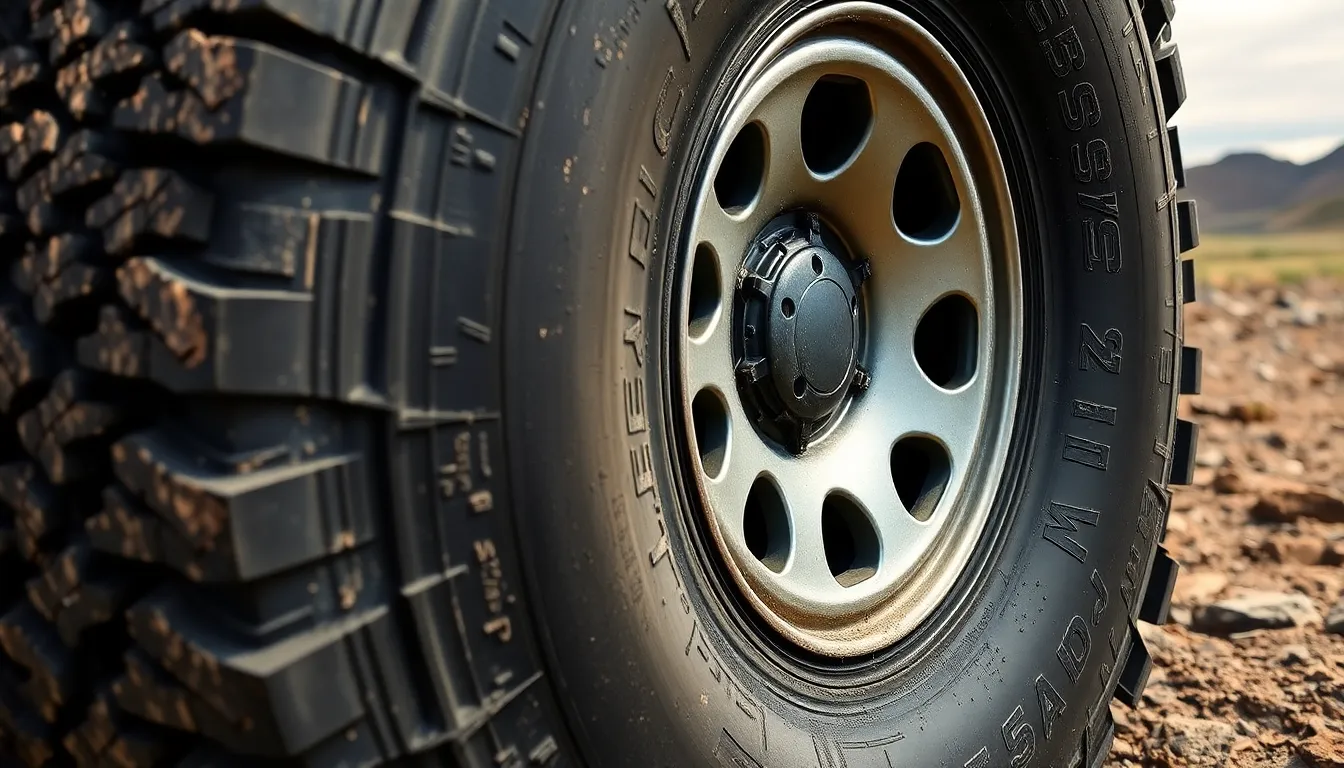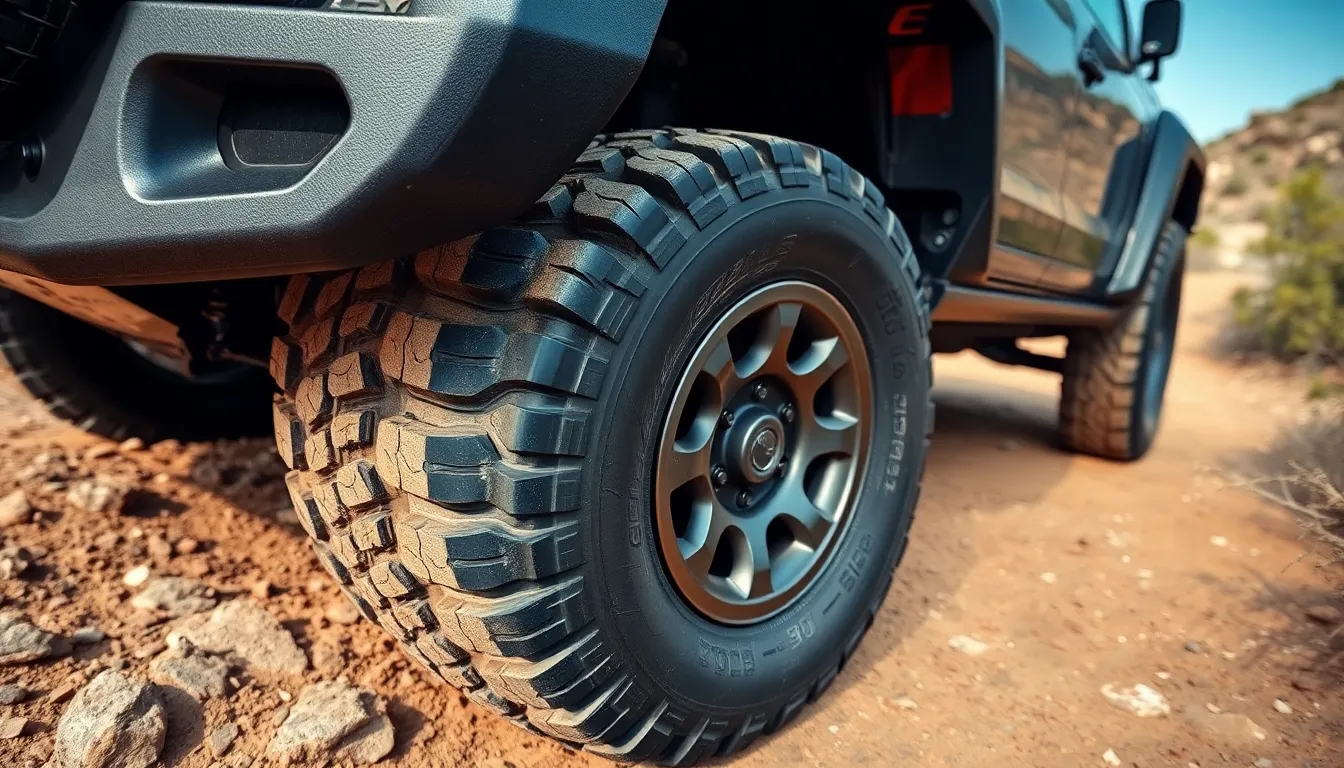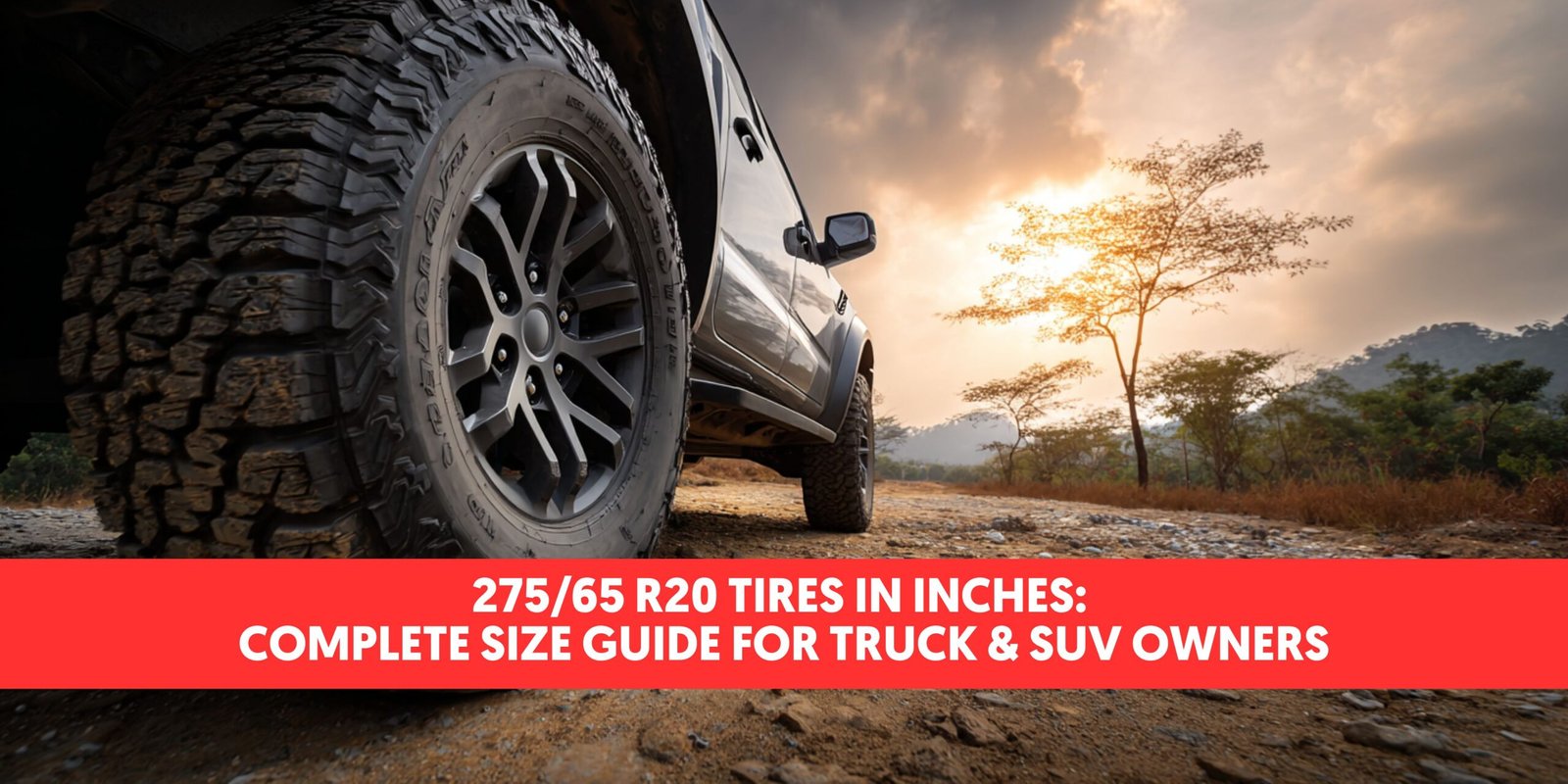Wondering what 275 65 R20 actually means in inches? This tire size code might seem like a random string of numbers, but it contains critical information about your vehicle’s performance and fit.
When you’re shopping for new tires or trying to understand your current setup, knowing the exact dimensions matters. The 275 65 R20 specification translates to a tire with a 275mm width, a sidewall height that’s 65% of the width, mounted on a 20-inch diameter wheel. Understanding these measurements helps ensure you get the right tires for your truck or SUV, preventing potential handling issues and maintaining your vehicle’s optimal performance.
Understanding Tire Size: 275 65 R20 Explained
Tire size codes follow a standardized format that communicates essential dimensions in a compact way. The 275 65 R20 designation contains three critical measurements that determine how a tire fits and performs on your vehicle.
The first number “275” represents the tire’s width in millimeters, measured from sidewall to sidewall. At 275mm (approximately 10.83 inches), this tire has a relatively wide footprint that offers excellent stability and traction on various road surfaces.
The second number “65” indicates the aspect ratio or profile of the tire’s sidewall. This percentage tells you that the sidewall height is 65% of the tire’s width. For a 275mm wide tire, the sidewall height equals 178.75mm (about 7.04 inches). Taller sidewalls typically provide more cushioning and comfort while driving.
The letter “R” signifies the tire’s construction type – in this case, “Radial.” Radial tires feature layers of cord material running perpendicular to the direction of travel, resulting in improved fuel efficiency, better handling, and longer tread life compared to older bias-ply designs.
The final number “20” specifies the wheel diameter in inches that the tire is designed to fit. This measurement refers to the distance across the wheel from one bead seat to the opposite bead seat. A 20-inch wheel requires tires with a matching 20-inch inner diameter for proper mounting.
Understanding these measurements helps you select compatible replacement tires and appreciate how tire dimensions affect your vehicle’s performance characteristics including handling, comfort, and fuel economy.
Converting 275 65 R20 to Inches: Complete Dimensions

The 275 65 R20 tire size contains critical measurements expressed in a mix of metric and imperial units. Converting these specifications to inches provides a clearer understanding of the tire’s actual dimensions for proper fitment and performance assessment.
Sidewall Height Calculation
The sidewall height derives directly from the tire’s aspect ratio of 65, representing the height as a percentage of the tire width. To calculate this dimension in inches, first multiply the width (275mm) by the aspect ratio (0.65) to get 178.75mm, then convert to inches by dividing by 25.4. This calculation gives you a sidewall height of approximately 7 inches. Taller sidewalls like these provide additional cushioning on rough roads, absorbing impacts from potholes and uneven surfaces for a smoother ride.
Overall Diameter Measurement
The overall diameter combines the wheel diameter plus twice the sidewall height. For a 275 65 R20 tire, this equals 34.1 inches (20-inch wheel + 2 × 7-inch sidewalls). This substantial diameter contributes to increased ground clearance for trucks and SUVs, making them more capable on rough terrain. The tire’s circumference measures approximately 107 inches, completing one full revolution every 107 inches of travel. During operation, these tires make about 592 revolutions per mile, a figure that affects speedometer accuracy and overall gearing.
| Dimension | Metric Measurement | Imperial Measurement |
|---|---|---|
| Width | 275 mm | 10.8 inches |
| Sidewall Height | 179 mm | 7.0 inches |
| Wheel Diameter | 508 mm | 20.0 inches |
| Overall Diameter | 866 mm | 34.1 inches |
| Circumference | 2,718 mm | 107.0 inches |
What 275 65 R20 Means for Your Vehicle

The 275/65R20 tire size significantly impacts your vehicle’s performance characteristics and appearance. These dimensions create exact effects that change how your vehicle handles, looks, and performs in various driving conditions.
Impact on Ground Clearance
The 275/65R20 tire increases your vehicle’s ground clearance due to its 34.1-inch overall diameter. This additional height provides approximately 7 inches of sidewall cushioning on each side of the 20-inch rim. Enhanced ground clearance improves off-road capability by allowing your vehicle to navigate rough terrain with less risk of undercarriage damage. Many truck and SUV owners appreciate this benefit when driving on unpaved roads, over obstacles, or through areas with uneven surfaces. The larger tire profile also creates a more commanding presence on the road, giving your vehicle a more aggressive stance compared to stock tire sizes.
Effects on Speedometer Accuracy
Your vehicle’s speedometer accuracy changes when upgrading to 275/65R20 tires from stock sizes. These tires complete about 592 revolutions per mile with a circumference of approximately 107 inches. Compared to smaller tires, each revolution covers more ground, causing your speedometer to under-report your actual speed. For instance, when your speedometer shows 50 mph with 275/65R20 tires replacing 275/55R20 tires, you’re actually traveling about 53.2 mph—a 6.4% difference. This discrepancy also affects odometer readings, making your vehicle appear to accumulate mileage more slowly than it actually does. Consider speedometer recalibration after installation to maintain accurate readings and avoid potential speed-related traffic violations.
| Comparison | Dimension Difference | Speed Impact |
|---|---|---|
| vs. 275/55R20 | +2.17 inches taller | 6.4% speedometer error |
| vs. 35/12.5R20 | Smaller tire | 2.7% speed difference |
Comparing 275 65 R20 to Other Common Tire Sizes

The 275/65R20 tire size offers exact performance characteristics that differentiate it from other popular dimensions. Understanding these differences helps you make informed decisions when selecting tires for your truck or SUV.
Visual Size Comparison
The 275/65R20 creates a distinctive visual profile on vehicles compared to similar sizes. Standing approximately 34.1 inches tall, this tire appears noticeably larger than lower-profile options like the 275/55R20. Many truck enthusiasts prefer the 275/65R20 for its balanced proportions, providing a rugged appearance without the extreme size of dedicated off-road tires. The 275/65R20 measures 10.8 inches wide, creating a substantial footprint that enhances both aesthetics and functionality. When parked next to vehicles with smaller tires, trucks equipped with 275/65R20 tires display a more commanding presence and elevated stance.
Performance Differences
The performance characteristics of 275/65R20 tires vary significantly from other common sizes. Compared to the 275/55R20, the 275/65R20 is 2.17 inches taller, affecting speedometer readings by approximately 6.4% – your speedometer will display a slower speed than you’re actually traveling. This height difference also translates to improved ground clearance, improving off-road capability on uneven terrain. The 35/12.5R20 tire stands 0.95 inches taller than the 275/65R20, resulting in a 2.7% speedometer difference.
The 10.8-inch width of the 275/65R20 creates a larger contact patch with the road, delivering superior traction in various conditions. These tires require wheels between 7.5 and 9.5 inches wide for proper fitment. The generous 7-inch sidewall height provides additional cushioning for a more comfortable ride quality compared to lower-profile alternatives. Larger diameter tires like the 275/65R20 slightly impact acceleration, braking response, and fuel consumption due to increased rotational mass and altered effective gearing.
Benefits and Drawbacks of 275 65 R20 Tires

The 275/65R20 tire size offers a exact balance of performance characteristics that can enhance or limit your vehicle’s capabilities. Understanding these pros and cons helps you determine if this tire size aligns with your driving needs and vehicle requirements.
Advantages
Larger diameter 275/65R20 tires provide superior ground clearance at approximately 34.1 inches, making them excellent for handling rough terrain. Their wider 10.8-inch tread width delivers enhanced traction and stability on various surfaces, giving you more confident handling in challenging conditions. These tires create an ideal balance between highway comfort and off-road capability, with the 7-inch sidewall height absorbing road imperfections for a smoother ride.
Disadvantages
Installing 275/65R20 tires can increase your fuel consumption due to their greater rolling resistance and weight compared to smaller tire options. Your speedometer accuracy will likely be affected, typically reading slower than your actual speed by about 6.4%. These tires may require recalibration of vehicle systems to maintain proper functionality, and can impact acceleration and braking performance if they’re not factory-recommended sizes for your vehicle.
Ideal Vehicle Applications
275/65R20 tires are commonly fitted on full-size pickup trucks, SUVs, and off-road vehicles requiring versatile performance characteristics. They’re perfect for vehicles needing a combination of highway comfort for daily driving and occasional off-road capability for weekend adventures. These tires are compatible with wheels measuring between 7.5 to 9.5 inches in width, fitting many factory-installed rims on modern trucks and SUVs without modification.
Terrain Suitability
275/65R20 tires excel in light to moderate off-road conditions including dirt roads, gravel paths, muddy trails, and snowy surfaces thanks to their wide tread pattern and substantial sidewall height. They provide reliable on-road performance with good stability and comfort on highways and paved roads during everyday driving. Their versatile design makes them suitable for most driving conditions, though they aren’t optimized for extreme off-road environments where specialized mud-terrain or rock-crawling tires would perform better.
Purchasing Guide for 275 65 R20 Tires

Selecting the right 275/65R20 tires requires attention to several key factors to ensure proper fit and performance for your vehicle. Confirming the 20-inch wheel diameter compatibility with your vehicle’s specifications is the first critical step in the tire selection process. Your vehicle’s wheel wells must also accommodate the 10.8-inch width of these tires to prevent rubbing during turns or suspension movement.
The overall diameter of 34.1 inches plays a important role in determining proper clearance with your vehicle’s body and suspension components. Tire clearance issues can lead to dangerous situations where tires make contact with vehicle components during normal driving conditions.
275/65R20 tires are particularly popular choices for light trucks and SUVs because they offer an excellent balance between:
- Enhanced off-road traction through their wider 10.8-inch footprint
- Comfortable ride quality from the 7-inch sidewall height
- Adequate load capacity for hauling and towing needs
- Improved ground clearance for moderate off-road use
When replacing tires with different sizes, be aware that moving to 275/65R20 from smaller sizes will affect your vehicle’s performance characteristics. For example, switching from 275/55R20 tires results in approximately 2.17 inches larger diameter, which impacts speedometer readings by causing them to underreport your actual speed.
The tire’s 107-inch circumference affects not only speedometer calibration but also influences your vehicle’s effective gear ratio, potentially altering acceleration feel and fuel economy. Many truck and SUV owners find these tires offer the right compromise between highway comfort and off-road capability without requiring extensive vehicle modifications.
Conclusion
Understanding the 275/65R20 tire size is essential when upgrading your vehicle or replacing worn tires. At 34.1 inches in diameter and 10.8 inches wide with a 7-inch sidewall these tires offer a versatile balance of performance characteristics.
They’re particularly well-suited for trucks and SUVs thanks to their enhanced ground clearance improved off-road capability and comfortable ride quality. Remember that installing these tires may require speedometer recalibration due to their larger overall diameter.
Before purchasing always verify compatibility with your vehicle’s specifications including wheel diameter wheel well clearance and load requirements. With the right 275/65R20 tires you’ll enjoy the perfect blend of on-road comfort and off-road capability for your driving needs.
Frequently Asked Questions
What does the tire size 275 65 R20 mean?
The tire size 275 65 R20 indicates a tire with a width of 275mm, a sidewall height that is 65% of the width, and designed to fit a 20-inch diameter wheel. The “R” stands for radial construction, which is the standard for modern tires. Understanding these measurements is crucial for selecting compatible tires for your vehicle.
How tall is a 275 65 R20 tire?
A 275 65 R20 tire stands approximately 34.1 inches (866mm) tall in overall diameter. This measurement includes both the 20-inch wheel diameter and twice the sidewall height. This larger diameter contributes to increased ground clearance, which is beneficial for trucks and SUVs, especially in off-road conditions.
How wide is a 275 65 R20 tire?
A 275 65 R20 tire is 275mm or approximately 10.8 inches wide. This width measurement refers to the tire’s tread width from sidewall to sidewall. The wider profile provides enhanced stability and traction, particularly beneficial for larger vehicles like trucks and SUVs.
How does the 275 65 R20 size affect vehicle performance?
This tire size increases ground clearance for better off-road capability and gives vehicles a more aggressive stance. However, it can affect speedometer accuracy (under-reporting speed by about 6.4%), impact fuel economy, and slightly alter acceleration and braking response. The larger diameter provides a smoother ride but may reduce fuel efficiency.
What vehicles typically use 275 65 R20 tires?
275 65 R20 tires are commonly used on full-size pickup trucks, SUVs, and off-road vehicles. Popular models include Ford F-150, Chevrolet Silverado, GMC Sierra, Toyota Tundra, Nissan Titan, Dodge Ram, Chevrolet Tahoe, Ford Expedition, and similar vehicles where the balance of on-road comfort and off-road capability is desired.
Will 275 65 R20 tires fit my vehicle?
To determine if these tires will fit, check your vehicle’s wheel diameter (must be 20 inches), ensure adequate wheel well clearance for the 10.8-inch width, and verify sufficient body and suspension clearance for the 34.1-inch overall diameter. Consult your vehicle’s manual or a tire professional to confirm compatibility before purchasing.
How does this tire size compare to other common sizes?
The 275 65 R20 is taller than lower-profile alternatives like the 275 55 R20, offering more ground clearance and cushioning. However, it’s shorter than larger off-road focused sizes like 285 70 R20. This size strikes a balance between highway comfort and off-road capability, with moderate effects on speedometer accuracy and fuel economy.
Do I need to recalibrate my speedometer with 275 65 R20 tires?
Yes, if you’re upgrading from a different size. The 275 65 R20 tire can cause your speedometer to under-report actual speed by approximately 6.4% compared to factory specifications. This means when your speedometer shows 60 mph, you’re actually traveling around 63.8 mph. Recalibration is recommended for accurate speed readings.
What are the benefits of 275 65 R20 tires?
Benefits include improved ground clearance for off-road obstacles, enhanced traction from the wider footprint, better cushioning from the taller sidewalls, and a more aggressive appearance. These tires offer versatility for both daily driving and weekend adventures with a good balance between on-road comfort and off-road capability.
What are the drawbacks of 275 65 R20 tires?
The main drawbacks include increased fuel consumption due to greater rolling resistance, potential speedometer inaccuracy requiring recalibration, slightly reduced acceleration performance from the increased rotational mass, and possible clearance issues in some vehicles. They may also be more expensive than smaller tire sizes.
